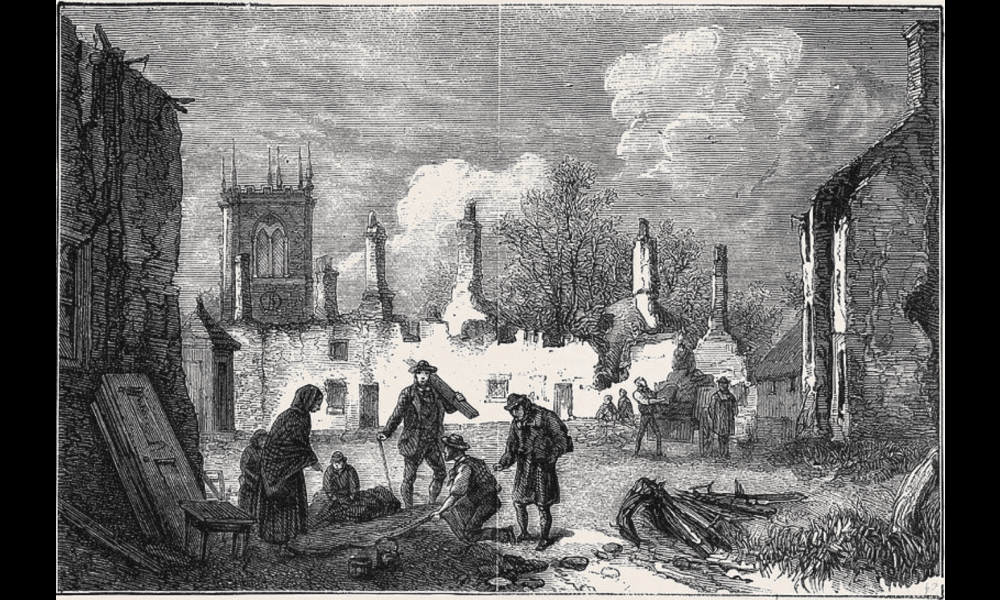1816 A Major Conflagration
• Mr. Stark's store on Sackville Street caught fire on October 9, 1816, a little before 10:00 in the evening. The fire spread to the exposures on either side, and from there, to some buildings on Hollis Street and Bedford Row. Altogether nine houses were burnt plus a string of smaller structures. Akin (History of Halifax City 1895, p. 177), referred to this incident as the “Halliburton” Fire, “in consequence of the brick building at the corner of Hollis and Sackville Streets owned by Mr. George Haliburton, having been the first house consumed”. However, his account is in direct contradiction with an Acadian Recorder article, which states that the fire started at Mr. Stark’s (Nova Scotia Archives 1816, p. 3). The Haliburton brick building’s interior burnt, but it prevented the fire from spreading further. Below is the article in question:
Destructive Fire
A little before 10 o'clock on Wednesday evening, a store in Sackville Street, occupied by Mr. Stark, unfortunately caught fire. The flames were soon communicated to the adjoining buildings, on either side, and from thence to those in Hollis Street and Bedford Row. At 12 o'clock, the sight was truly dreadful, flakes of fire fell in every direction, and fears were entertained for almost every house in that part of the Town. Happily, however, the wind was extremely light; a hoar frost, which felt thickly, contributed much to deaden the particles of fire which were scattered on the contiguous buildings; and by three o'clock, [...] the danger began to subside.
The houses destroyed by fire were those belonging to Mrs. Kavanagh, widow, occupied by Messrs. Stark and D Fraser; the large and handsome brick buildings belonging to Mr. G. M. Haliburton, occupied by Mr. McDonald and J. Martin; a house occupied by D. Connor; and that of J. T. Hill, Esq. in Hollis Street; the houses belonging to Messrs. King and Vass, the former occupied by Mr. M. Smith and others, in Bedford Row, and several smaller buildings. The late W. Graham's house, Mrs. McDonald's Mrs. Hawkin's (occupied by Dr. Thompson,) Miss Wenman's and those occupied by Messrs. Poor and Jennings, were taken down under the direction of the Magistrate and Fire Wardens, as the only means of preventing further destruction, and several other sustained very serious injury.
His Honor the Administrator was present and nearly all Troops of the Garrison were actively employed on the occasion, as were the officers and men of his Majesty's ships and Naval Yard. The Commandant remained near the fire until half past 3 o'clock, A. M. when, the flames began to abate, the horn blew, and the men, exhausted with fatigue, were permitted to retire to their Barrack.
One of the many cards of thanks
• The Firewards met the day of the fire (October 9, 1816) and stated that six houses had been pulled down to stop the fire from spreading further. The Firewards who gave the orders, at one point or another, for these houses to be demolished were James Fraser, John Liddell, Richard Tremain, Frederick Major, John Pryor, John Albro, Patrick Ryan, Michael Tobin, Thomas Wallace, and John George Pyke. This fire was the largest ever recorded at that time, and when the Firewards met again at the Exchange Coffee House on December 7, 1816, they found a report from a meeting that had been held by the inhabitants, in which they explained their view that the town needed to procure a "forcing pump or an engine with suitable hose, for the use of the Town of Halifax." The Firewards then asked the Justices in Session to assess the town for £250 to pay for the expenses of importing a new fire engine, along with 800 feet of hose. Thomas Fillis (Phoenix Fire Company) having retired as a Fireward, John Clarke was appointed to replace him (Nova Scotia Archives 1804-1835).


